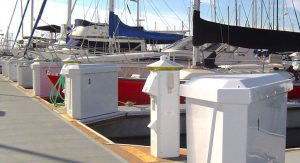When you are looking to purchase a vessel from overseas, the saying ‘t

oo good to be true’ could apply. There will almost always be additional costs to importing. Some costs to consider on top of your purchase may include GST, the cost on duties, agent fees, reflagging costs, shipping costs, removal of refrigerants and potential changes to the electrical system that may be costly.
Whether you are importing privately or for commercial purposes, it is generally your responsibility to ensure that the electrics of your vessel comply with the Australian standard. However, If it is greater than 35m then it does not have to meet the AS/NZS 3000:2007 code rather it must meet SOLAS. If less than 35m than it (subject to other requirements) must meet AS/NZS 3000:2007 standard used in Australia, also known as the Australian/Zealand Standard for Wiring Rules, or simply known as the wiring rules.
In terms of electrical installations, Australian wiring rules generally require protection to be installed against:
• contact with live electrical components;
• risk of fire;
• overcurrent/ overheating;
• arcing faults; and
• water damage.
Failure to comply with these standards could have catastrophic consequences such as fire or electrocution and the legal consequences that can flow. For instance, if you purchased and imported a vessel from overseas, which ran on a different voltage than in Australia, and plugged it into an Australian marina, there is not only potential damage to the electrical systems of your vessel, but also the marina itself. Insurance issues for example could end up being unnecessarily complex and disastrous.
Isolation Devices
The wiring rules also require the installation of isolation devices in all active conductors but must not interrupt a neutral conductor unless allowed for in the wiring rules. This is to prevent faults such as short circuits and to allow for the maintenance of electrical equipment. Isolation devices must not conduct an ‘earthing’ conductor.
This is important because there are some countries that do not have this requirement. And as a result, there is a chance that the vessel that you wish to import may not have such isolation devices installed.
On shore power differences
Another thing to consider is that the power systems used can differ greatly from country to country. Because of this, there is a chance that the on-board electrical equipment may not work in Australia. Below is a table of the different voltage systems across various countries.
| Country | On Shore Voltage Systems |
| Australia and New Zealand | 240/415V or 250/435V @ 50Hz AC
12V DC |
| United States | 110/220V, 120/240V 60Hz AC
12V/24V DC |
| Most European Union Countries | Ranges from 230-250V @ 50Hz AC |
| United Kingdom | 240/415V @ 50Hz AC |
| Italy | 127/220V or 230/380V @ 50Hz AC |
| Cayman Islands | 120/240V or 120/208V @ 60Hz AC |
| Norway | 230/400V @ 50 Hz AC |
| China | 220/380V @ 50Hz AC |
| Taiwan | 110/220V or 120/208V @ 60Hz AC |
| Korea | 110/220V or 220/380V @ 60Hz AC |
After looking at this table, you will see that electrical standards differ greatly across different countries. If you are looking to import a vessel into Australia, it is strongly advised that you have a qualified electrical surveyor check that the electronics of your vessel is in accordance to the wiring rules.
In the case that the electronics of your vessel do not comply with the wiring rules, then it is advisable to have a qualified electrician make the relevant conversions, such that they would comply with the AS/NZS 3000:2007.
